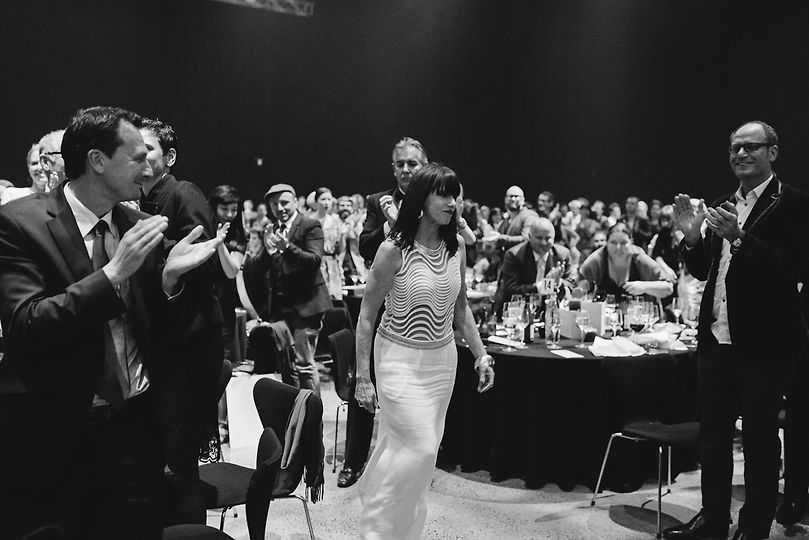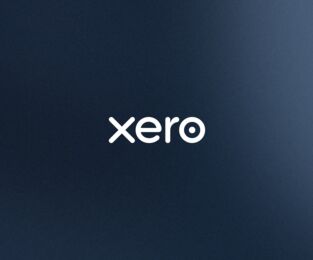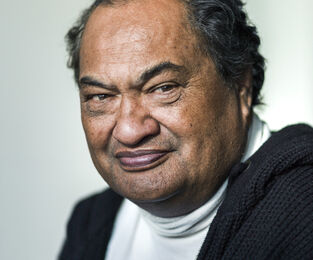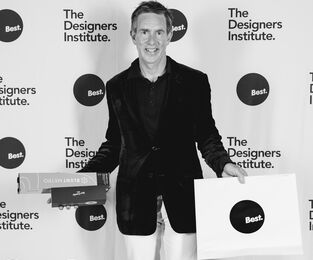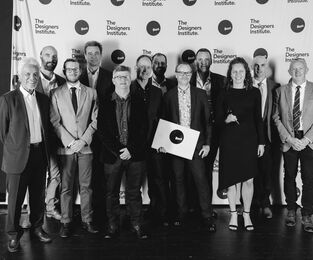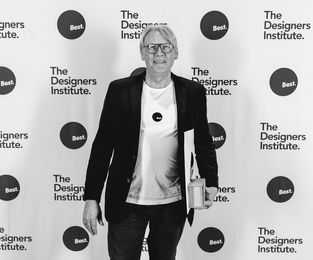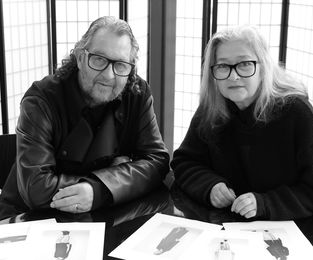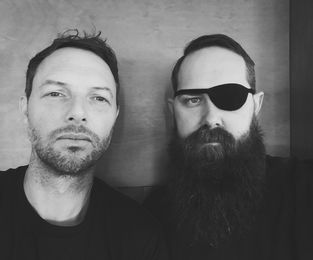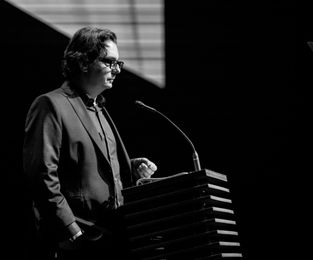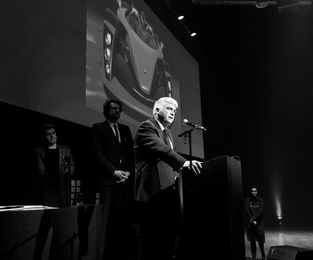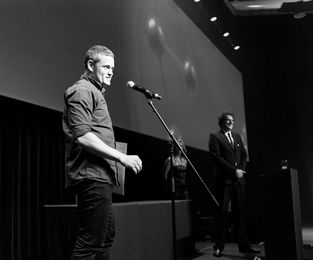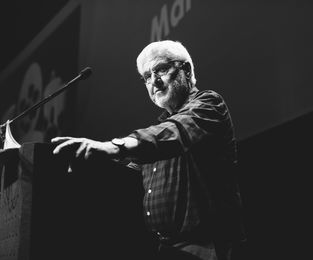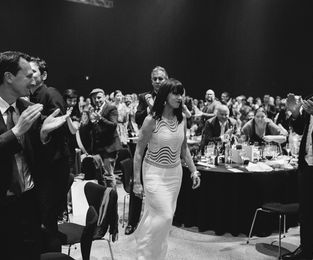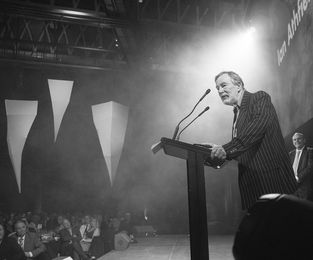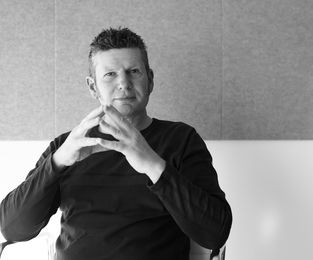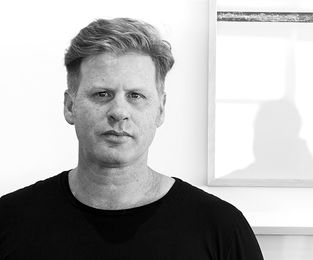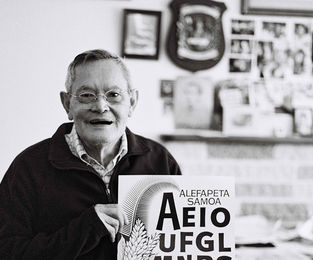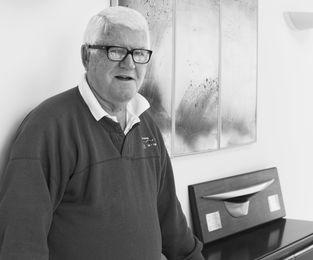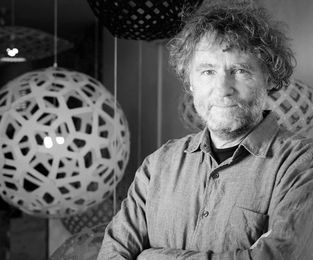In 2020 this Black Pin was given to Liz and Neville Findlay, founders of fashion label Zambesi. We spoke to them about the journey so far.
Q: Liz, so you came to New Zealand from Greece?
Liz Findlay (LF): Yes. I was born in Greece and my older brother as well. My mother is Greek, but she was born and brought up in Russia. My father was Ukrainian and they met in Germany towards the end of the war. My family immigrated to New Zealand in 1951 on a vessel called the Goya.
Q: So… what language did you speak at home?
LF: My parents wanted to learn English, so although we learnt some basic Greek and Russian we were encouraged to speak English. I can still understand a few words. We have a few Russian and Ukrainian staff at our workroom so it feels a little familiar hearing them speak to one another.
Q: It is quite a multicultural office.
Neville Findlay (NF)
Yeah, very much so!
LF: I think the thing with language is that if you're not using it in your home or in your workplace, you know, you don't retain it. Maybe if I had married a Russian or Greek, life with language would be different, but I didn't!
NF: Instead, you ended up with a Syrian Scot!
LF: Our girls are a real mixture!
Q: Do you think that internationalism in any way colours your output as a creative?
LF: I don't think you consciously do that. I think that it's probably just inherent. My grandfather was a shoe maker in Russia so maybe it was in the genes! When we moved to Dunedin from Central Otago – my mother went to work for a local designer, as a seamstress. She loved making clothes and was very creative. She would manipulate patterns, make all our clothes and taught us all to sew. So, it could be that generation did make their own clothes and were used to doing it for themselves. So, that creative thing, I think, was encouraged by both my parents.
NF: It was born of necessity. They would do and make everything, it was part of the culture.
Q: Were you interested in a career in fashion from an early age?
LF: It did not enter my mind as a career at a young age. I loved being around fashion, fashion shows, fashion magazines etc. I loved being around clothes and dressing up. I loved sneaking into my mother’s wardrobe and drawers when she was out and trying on all her clothes, shoes and jewellery. I do not know whether she realised at the time but she never said. I was fascinated by her choices and everything was beautifully folded and boxed. My mother had a passion for clothes and was always making garments for us. She had this wonderful, big, travelling chest that had come to New Zealand with us in 1951 and it was always full of remnants. So we were often taking from and adding to that treasure trove of fabrics, making something to wear and buying remnants of fabric from our favourite store Penroses in Dunedin. We were taught to sew by our mother who was very particular and adept at manipulating patterns and a seamstress by trade. I think it was her passion that rubbed off on me. It was more about putting them on my back and not really on anyone else’s at that stage.
Q: Were you already playing around with your own designs and developing your own style at that stage?
LF: I think I had a particular style and loved mixing things up.
NF: But you already had a contemporary bent rather than a classical bent, didn't you? I remember you always wanted to shop at the latest boutiques.
LF: Oh, yeah, but I loved vintage too and classics that could be twisted a little.
Q: Were fashion brands and labels that big of a deal back then?
LF: Well... yes, there were a lot of boutiques and stores with their own brands and I think there has always been a market for fashion on many levels. There were hardly any imports because duties were so high and local manufacturing was protected. This allowed the industry to grow and develop without a lot of competition.
There were also a lot of boutiques around when I started. Really unique. They were all very individual in their presentation and environment. Very authentic. I feel like there is a return to that now.
Q: So what was your first ‘industry’ job.
LF: I guess my first introduction to the industry was working for a company in Auckland in the office of Derek Batts, a clothing manufacturer and wholesale brand. I got in through the admin, of course, because that was where, you know, my skills were. But then I asked if I could go through to production. I was fortunate enough to be given this opportunity and I learnt a great deal from a planning point of view and learnt to operate industrial machines. I then went on to work in a retail environment and a fabric importer and lastly in a small workroom with a very creative team and this was very inspirational. These varied roles have been invaluable to me in my career and I am sure that the experiences and education in the industry have laid a good foundation for my role at Zambesi.
Q: And when did you arrive at that moment when you said ‘I want to do my own thing’?
LF: Oh, well, actually, I have probably never arrived at that moment! [laughter] Looking back it seemed inevitable. Neville and his friends used to say: 'you always look so different, the way you put things together! Why don't you do your own thing? Why don't you start your own label? And then we went... ‘oh, OK,’ so we started thinking about it seriously.
NF: That came along with the desire to maybe own a little boutique for starters. There was that retail side and the creative side.
LF: Yeah, I think it was just a very natural evolution, if you like, it was an organic kind of thing. So we decided to take on a space that was called ‘Rhubarb’ in Parnell Village and we changed the name to ‘Tart’ because that whole area had all these weird 70s names like: ‘Roots, Shoots and Leaves’ (a plant shop) [Laughter] Can you imagine?! And another called ‘So to Bed' (an antique shop) and ‘Snatch Factory’ which was a knitwear shop. Yeah…. so we were Tart! We opened in 1976.
Q: Sounds very 70s indeed! What was your business model?LF: I used to go and buy all the brands that I liked, and sell them. And then I started making pieces that I felt we were missing. So I kind of started very slowly. We retailed for about three, four years and a couple of the brands we were buying were opening their own stores and didn't want to supply us anymore. So, we thought, well... how do we protect what we're doing? And that would be creating our own brand. When we established Zambesi in 1979 it was to create an identity that represented our philosophy of strength, beauty and independence.
Q: Is that when you guys started thinking about interior design and how a physical space could represent the garments.
NF: The first couple of stores were pretty nondescript mainly because we didn’t have any money. When we went to Vulcan lane is when we decided we were going to do a number.
LF: It coincided with Neville having decided to leave his job.
Q: What was your job at that time?
NF: I was an automotive product designer, I had a pretty responsible job at a young age and designed a factory that built exhaust systems for cars. We just used to make the componentry like air filters, oil filters, mufflers, all that sort of thing.
Q: Is that where your passion for cars started?
NF: Oh no, it started well before that! I luckily got into a job that I was interested in. So I sort of ended up running one of the group companies and I set up an industrial filtration division within this company. So, I had a nice little career going on.
Q: Quite a daring move then to just sort of quit that and move into a budding fashion label?
LF: It was kind of the right move, at the time. Have you regretted it?
NF: No. Not at all!
LF:That's good. You could always start up again and get a really good job!
NF: From my perspective, I was ready to move because I sort of moved into that sort of management side of it, and I wasn't doing so much of my hands-on design, and I didn't really enjoy that as much. And I thought... I would rather get back to doing something, you know,
LF: Rather than sitting around the boardroom!
Q: And the rest is history! Any tips on how to build a long-lasting, family business in the creative industries?
NF: Making your own rules. I think we made it up as we went along.
LF: But also, it was never about who was getting the credit for anything or who did this job and who did that job. I think we're really lucky in that our personalities fit the job and Neville has always been incredibly supportive and generous giving me the freedom to do what I believe in. He's never tried to step in or change it.
NF: We've always worked the brand forward. We've also tried to stay away from being market-led but more design-led. So it's never been like chasing the big numbers, it's been more about doing something individual and creative.
LF: Yes, our motivation wasn't about making money, even though... we desperately needed some! [laughter] I think we just let it grow organically. We started working from home with one staff [member], and then it was two, and then we opened our first workroom.
NF: We went into Australia, which was kind of a tough market.
LF:Yes, it was. We're not saying that this is how it should be done. It's just the way that we've done it, and grown it and become proud of it, I suppose. For us the integrity behind what we do and being authentic and being honest about it, and not trying to oversell ourselves, that's been really important for us. Now, of course, you know, you're confronted with this whole social media marketing thing, which I struggle with, to be honest. But luckily, our daughters are involved with us, and they both are very creative and bring fresh ideas to the table. We are blessed to have them work with us presenting shows, videos and images and taking care of social media.
Q: You guys have created a very distinct brand. Was it something that you consciously defined?
LF: I don't think we've ever really had a strategy or a plan. The first few years I was probably experimenting and creating an identity without trying to do that. You slowly start editing your own work, and you start leaving out the things that you're not happy with, or you want to move on from and focus on the work that really attracts you.
Q: Like black.
LF: Yes, I've always loved black because you know, we wear a lot of it, so that has become the kind of backbone, I guess, of the brand. People always go ‘but you only do black!’ And no, we don't, we actually do other colours, but black seems to be our signature. Black is never just black to me! It has depth and layers and textures.
NF: I always compare it to black and white photography. You can see a lot more in a black and white photography: the texture, the light, the graininess, all those sorts of things. I think that that is why black clothes have an appeal to a lot of people.
LF: Another part of that brand aspect is that people always feel like they have ownership of it in a way. Somehow you feel like it belongs to you and I think it is because they connect with us through our interiors, our shows, our music. All those things contribute to the identity of the brand and the way that people perceive the brand.
NF: Also because we leave, you know, we leave a little bit out. Like we don't try and define the way people dress, we create a vehicle for them to become the stylist rather than us pushing an entire look or series of looks. They get a lot of joy and buy-in from doing that. Quite often Liz will see someone wearing something she designed and think 'wow I didn't think of styling it like that!'
Q: Do you outsource any of the components of the business?NF: We do everything in-house and sometimes it's a little bit naive, and we ask: can we get away with it? And I think because it's fully ‘ours’ people accept it, because it's the Zambesi way. Like, totally, we try and do everything from our graphic design, to interior design, show design, styling etc.
LF: And by that, we mean our creative team. We have a menswear designer and a womenswear design assistant to me and an incredibly skilled workforce and creative team. The process from design to production and completion is in house. So it's kind of a team effort, a family effort, in many ways that's what is underpinning the longevity of the brand.
Q: How would you describe your customer? Like, if you had to imagine a demographic or an ‘avatar’.
LF: Individual and confident. Someone once said to me that we're like little tribes, you know, I belong to your tribe, because of the way that we dress and I love what you do, and I wear it. So that's, you know, like, without meaning to or thinking about it, you do create these kinds of cults or clubs or followings.
Q: Which have the same music, similar dress styles...
LF: Yeah, we enjoy the same things. You know, we were drawn to the same kind of architecture or art or film. Yeah, all of that stuff, but you don't set out to try and capture that.
Q: Has being ‘Made in New Zealand’ a contributing factor to that success? Has local culture given Zambesi something you wouldn’t have gotten anywhere else?
LF: Well, I wonder whether we would ever have done anything like this anywhere else. I think what New Zealand offers us this amazing freedom, you're not...
NF: Daunted?
LF: Yes, daunted by fashion history. People used to say ‘why don't you and your brand go to Paris?’ and we did and have done our stint offshore. However, we have come back to our comfort zone and are not concerned with making it anywhere but here! On-line of course has changed things!
Q: But you did end up going to Australia though.
LF: We had retail stores in Sydney and Melbourne for 25 years and we still wholesale in Australia. When we opened in Sydney we opened a small store in the beginning and then gravitated to this amazing space, a ballroom. Five years later we found out no one wants to go up in a lift to the ballroom!
NF: It was a difficult task to break into that market. We succeeded but it had to do with the fact that they saw us as disruptive, they were weary.
LF: I remember when we first went to a client meeting there, one of them looked at our clothes and said “Where is the pink?” [LAUGHTER]. Trend of the season?
NF: It was a bit like ‘what are you doing here?!’
LF: It was the first time I thought ‘ohhh, this could be fun’!
NF: We did win them over in the end.
Q: Have there been any key disruptors to your industry during the years that you've been in the business?
NF: Covid and online shopping!
LF: You could say online shopping was a little bit disruptive in the beginning, because, like, we've been buying imports, you know, for many years, like Margiela and Rick Owens and all the brands that we like... Raf Simons… and we used to have them delivered at the right time for our season. We used to delay it so that the summer collection from Europe arrived in our summer. Online shopping has changed all that. Now we need to have it at the same time as it's up online but it has to suit our climate as well. So it has been disruptive but it's also been something we've had to make work for us.
Q: You pulled out of Australia recently… is there a future in brick and mortar?
NF: For us it is essential.
LF: Like me, some people need to touch and feel. We have a lot of clients that want to try it on, see it on themselves, get your opinion. Online shopping doesn’t do that for you.
NF: It has to be an inspirational experience.
LF: In saying that, we have shrunk the number of shops that we used to have. I don’t think you need as many anymore.
NF: We are doing quite well online so it doesn’t feel like we need three stores in Auckland anymore.
Q: How do you keep coming up with new ideas after so many years in business, what are your techniques for maintaining creativity flowing.
LF: I don’t know… a lot of it is the team. They stimulate me as well and they are very inspirational. They believe in the brand and they get excited when things are going well.
We try more and more to involve them in our processes. For a long time it was a lot about me, and what I wanted to do and how it got done… and it is still a little like that but now we get feedback from stores, from online and [our daughter] Marissa is a photographer and works closely with the stores and fashion week and our PR and social media and Sophie looks after the website, graphic design and music direction and [both daughters] whom we are incredibly proud of keep us grounded and on our game. They are very involved with that part of the business which has made us rethink how we really need to be quite open to our ‘Zam-fam’ as we call them, and what they bring to the table as well.
Q: You have also mentored or helped the careers of many amazing designers in the industry who went on to make their own brands…
LF: People move around because they are exploring. I did that, I worked in the industry in many different areas. We have had some great people come through our doors and go on to do their own thing.
Q: You don’t feel there is a tug-o-war between mentoring and helping people grow but also keeping that talent within your stable?
LF: No, because if you start freaking out about someone else’s creative talent vs yours, then it becomes a competitive thing and I don’t think that way. Even with our peers and other brands… everyone is unique. Everyone who has worked here has contributed to Zambesi but understands the brand… it has always been about our brand and even if they leave to do their own thing, even if it is similar, it is still not ours, it is theirs.
NF: If you think of someone like Murray [Crane] for example, he went on to do suits. Nothing to do with Zambesi.
Q: What excites you about the NZ fashion scene at the moment?
LF: It’s got a great future. What we need to ensure is that we can manufacture here if we wish to. We are NZ made and we want to keep it that way. Not to say that we will never manufacture offshore.… At this stage, there is no plan to do that, but to encourage the new generation there needs to be that infrastructure here to be able to access that.
NF: Covid has almost saved the industry in a way.
LF: You think so?
NF: Yeah, five years prior to that, there had been a real decline in local manufacture and by designers going to China, etc.
LF: I agree I think a lot of designers are coming back to local manufacture, and that is a great thing for them. What we need now is to encourage and improve the skillset, and that is the hard thing. Because our machinists are scarce and I have talked to a few of the design schools and institutions discussing the need to encourage craft because not everyone is going to be a designer. There are so many processes in making clothes that require skilled craftsmen. There is so much satisfaction in creating a beautiful garment and being part of a creative team.
NF: There needs to be more status placed on the artisanal side of making clothes.
LF: Yes, it is not just being able to draw an amazing picture or dream up something in your head because if you did that all day you would never be able to produce all your ideas.
NF: You need a balance of skills.
LF: And we need to encourage creatives who are good with their hands. To make garments and to feel satisfied with that. There is a great future. Look at where it has been in the last 20 years. Look at Fashion Week, that has been encouraging for existing and new designers. Gives them a voice.
Q: A couple of years ago you announced that Zambesi was for sale.
LF: Yes, we announced that pre-Covid. It was Fashion Week 2019. We had a buyer… but then Covid happened and they withdrew.
NF: After that, we thought it was meant to be.
LF: Obviously, Neville and I are getting on but… we still have a lot of energy left, I think! Actually, I love making clothes and am so lucky to still be doing something I love!
NF: There is still a bit in the tank!
Q: So we are not going to see you as a full-time racecar driver anytime soon?
NF: Not full time no, but if I get the call… I’ll be ready!
